Blog
HOW TO GROW BOUGAINVILLEA INDOORS AND OUTDOOR
Bougainvillea is not your typical houseplant—in its natural state, it's a sprawling climber and shrub with formidable thorns, often found on the exterior of buildings (like climbing up a trellis or over a fence) or in gardens in subtropical-to-tropical climates. Best planted in the spring, bougainvillea is a quick grower, often adding more than 36 inches in length per year. It's known for its green foliage and vibrant pink, purple, and orange hues that most people assume are the plant's flowers—however, they're actually petal-like bracts that hide bougainvillea's true blooms, which are typically small white or yellow buds.
If you don't live in a warm enough climate to successfully grow bougainvillea outdoors year-round, you're in luck—the shrub is surprisingly easy to grow inside in containers or pots and can thrive and bloom indoors if the right conditions are maintained. Outdoor bougainvillea plants can be brought indoors for the winter using the care tips below.
Common name | Bougainvillea, lesser bougainvillea, paper flower |
Botanical name | Bougainvillea |
Plant type | Perennial, shrub |
Mature size | 15–40 ft. tall, 15–40 ft. wide (outdoors); 2–6 ft. tall, 1–3 ft. wide (indoors) |
Sun exposure | Full |
Soil type | Moist but well-drained |
Soil pH | Acidic |
Bloom time | Spring, summer, fall |
Flower color | Pink, purple, red, yellow |
Bougainvillea Care
Native to South America, bougainvillea was named in honor of Louis Antoine de Bougainville, a sailor and explorer during the late 1700s. Despite its showy nature, bougainvillea is not a particularly high-maintenance plant. The vine-y shrub typically blooms three times a year once established, often going dormant and losing its leaves, bracts, and flowers during the cooler winter months. It prospers best in tropical or semi-tropical environments, and will therefore require lots of water and sunlight whether planted indoors or outdoors.
Bougainvillea needs to be trimmed to maintain its shape, but too much aggressive pruning of new growth will reduce bloom color. The best approach is to prune in the fall after the growing season is complete so the plant will bloom from next season’s new growth.
Light
Bougainvillea plants are lovers of sunlight and need full daily exposure to thrive. Another important note: The color saturation of your bougainvillea relates to how much sunlight it gets—more light equals brighter hues.
Soil
When it comes to soil, bougainvillea plants thrive in a moist but well-drained potting mix that's slightly acidic (between a 5.5 and 6.0 pH level). Top your mixture with compost to ensure a rich, nutritious soil, and opt for a pot with at least one drainage hole in the base to lower the risk of root rot.
Water
Keep your plant evenly moist during the spring, summer, and fall months, and nearly dry in winter (bougainvillea blooms better with drier winter conditions). Water your bougainvillea to saturation, then let the first inch or so of soil dry out before watering again. Too much water can lead to overly-green growth and eventually root rot; too little, and the plant can wilt.
Temperature and Humidity
Bougainvillea is a relatively hardy plant, able to withstand a range of temperatures, from tropical highs of 80 degrees Fahrenheit and above, all the way down to 40 degrees Fahrenheit, the lowest temperature it can tolerate. Due to its tropical origins, humidity is helpful, too—spritzing the plant with water isn't necessary, but if your home is particularly dry a small humidifier near your bougainvillea can help.
Fertilizer
Bougainvillea requires a lot of nutrition to produce blooms throughout the season, especially indoors (where almost all plants are less likely to bloom as frequently). For the best chance at a successfully full plant, feed your bougainvillea every seven to 10 days using a weak liquid fertilizer. There are several fertilizer blends specifically geared toward bougainvillea on the market, but one formulated for other tropical plants, like hibiscus, can work too.
Potting & Repotting
When choosing a vessel to plant your bougainvillea in, always opt for a larger size than you think you need. Bougainvillea spreads rapidly and, in suitable environments, will quickly grow into small trees or large shrubs several feet high. To keep things manageable in containers, control the plant's growth with yearly repotting and root pruning in the spring. Once the plant is large enough, aim to repot it every two years.
Moving Bougainvillea Outdoors for the Summer
Because this plant loves light, many growers choose to move their potted bougainvillea outdoors during the summer months to ensure it gets enough rays.
Can You Grow Bougainvillea Inside?
You can grow bougainvillea indoors. To make bougainvillea truly thrive indoors, maintain your home's indoor temperatures around 60 to 70 degrees Fahrenheit. During the winter months (or if choosing to keep your plant indoors full-time), opt for a sunny spot near a big window and consider rotating your plant throughout the house as the day progresses to give your bougainvillea enough indoor light. Bougainvillea is often a popular plant to prune into an indoor (or outdoor) bonsai tree.
Common Pests & Diseases
Outdoors, bougainvillea can experience a few pests, most notably the bougainvillea looper caterpillar, which feeds on the leaves of the plant. However, when indoors, you may want to keep an eye out for mealybugs, a common indoor pest. Mealybugs appear most often on the stems and leaves of a plant, identifiable by the fuzzy, white mass they create as they group together. Mealybugs feed off of new growth, eventually damaging the leaves and causing them to yellow and die. To rid your bougainvillea of mealybugs, treat it with neem oil weekly until they've died off.
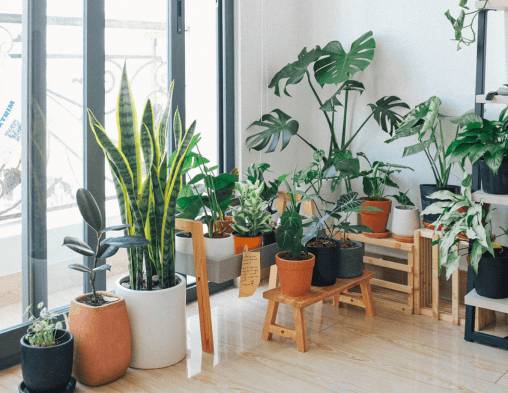
BEST INDOOR HOUSE PLANTS WITH CARE & BENEFITS
Indoor plants are a great way to add some greenery and freshness to your home or office. They can also provide many benefits for your health and well-being, such as improving air quality, reducing stress, and boosting mood. In this blog post, I will introduce you to some of the most popular and easy-to-care-for indoor plants, and give you some tips on how to choose and maintain them.
Some of the most common indoor plants are:
Fiddle leaf fig (Ficus Lyrata): This plant has large, glossy leaves that make a statement in any room. It needs bright, indirect light and regular watering. It can grow up to 10 feet tall indoors, so make sure you have enough space for it.
Chlorophytum comosum
Spider plant (Chlorophytum comosum): This plant is very adaptable and low-maintenance. It produces long, arching leaves and small plantlets that hang from the stems. It can tolerate low to bright light and occasional watering. It is also known to purify the air by removing toxins
Spathiphyllum
Peace lily (Spathiphyllum): This plant has elegant white flowers that contrast with its dark green leaves. It prefers low to moderate light and moist soil. It can also filter out harmful chemicals from the air, such as formaldehyde and benzene
Air plant (Tillandsia): This plant does not need any soil to grow, as it absorbs water and nutrients from the air. It has thin, spiky leaves that come in various shapes and colors. It needs bright light and weekly misting or soaking. It can also produce colorful flowers when it blooms
Air plant (Tillandsia): This plant does not need any soil to grow, as it absorbs water and nutrients from the air. It has thin, spiky leaves that come in various shapes and colors. It needs bright light and weekly misting or soaking. It can also produce colorful flowers when it blooms
Aloe vera
Aloe vera (Aloe barbadensis): This plant has thick, fleshy leaves that store water and gel. It needs bright light and occasional watering. It can also be used for its medicinal and cosmetic properties, such as soothing burns, cuts, and skin irritations.
To choose the best indoor plant for your space, you should consider the following factors:
Light: Different plants have different light requirements, ranging from low to high. You should match the plant to the light level of your location, such as a window, a shelf, or a corner. You can also use artificial lighting to supplement natural light if needed
Water: Different plants have different water needs, ranging from dry to moist. You should check the soil moisture of your plant regularly and water it accordingly. You should also use water that is at room temperature and free of chlorine and fluoride
Humidity
Humidity: Different plants have different humidity preferences, ranging from dry to humid. You should monitor the humidity level of your environment and adjust it if necessary. You can use a humidifier, a pebble tray, or a spray bottle to increase humidity.
Fertilizer
Fertilizer: Different plants have different fertilizer needs, ranging from low to high. You should feed your plant with a balanced fertilizer that is suitable for its type and growth stage. You should also follow the instructions on the label and avoid over-fertilizing.
To maintain your indoor plant, you should follow these general tips:
Prune
Prune: You should trim any dead, damaged, or diseased leaves and stems from your plant to keep it healthy and tidy. You should also remove any faded flowers to encourage new blooms. You should use clean and sharp tools to avoid infection and injury
Repot: You should repot your plant when it outgrows its current pot or when the soil becomes compacted or depleted. You should choose a new pot that is slightly larger than the old one and has drainage holes. You should also use fresh and well-draining potting mix that is appropriate for your plant.
Pest and disease control: You should inspect your plant regularly for any signs of pests or diseases, such as insects, mites, fungus, or mold. You should use natural or organic methods to treat them, such as neem oil, soap spray, or rubbing alcohol. You should also isolate the affected plant from other plants to prevent spreading
Indoor plants are not only beautiful, but also beneficial for your home and health. By choosing the right plant and taking good care of it, you can enjoy its presence and perks for a long time.
I hope this blog post has given you some useful information and inspiration for your indoor gardening journey. Happy planting!
View More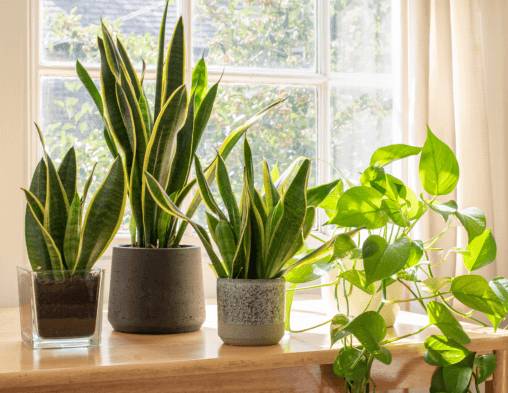
SNAKE PLANT WITH ITS CARE & BENEFITS
Snake Plants: A Stylish and Low-Maintenance Addition to Your Home
Snake plants, also known as mother-in-law’s tongue or scientifically as Sansevieria, have become increasingly popular among indoor plant enthusiasts. Their striking appearance, air-purifying capabilities, and low-maintenance nature make them a favorite choice for both beginners and seasoned plant lovers. In this comprehensive blog post, we’ll delve into the world of snake plants, covering everything from care tips to propagation techniques.
1. Types of Snake Plants
Let’s start by exploring the diverse varieties of snake plants:
This is perhaps the most well-known variety. Its long, tall, pointed leaves grow upright and are usually green with yellow variegation. Sansevieria trifasciata is not only easy to maintain but also excels at purifying the air.
Sansevieria Cylindrica:
Unlike its trifasciata counterpart, this variety boasts cylindrical leaves that shoot straight up, creating a modern and eye-catching appearance. Its dark green color and unique texture make it a standout choice.
Sansevieria Laurentii:
With striking yellow borders on its long, pointed leaves, Sansevieria laurentii adds a touch of elegance to any room. The contrast between the yellow edges and green leaves is visually appealing.
Sansevieria Zeylanica:
Thin, upright leaves with white variegation characterize this variety. It’s a subtle yet beautiful addition to your indoor space.
Sporting silvery-blue leaves, Sansevieria moonshine brings a cool and serene vibe to your home.
Sansevieria Masoniana:
Known for its large, paddle-like leaves, this variety is a favorite among plant enthusiasts. Its bold appearance makes a statement in any room.
2. Watering and Soil
Snake plants thrive on neglect. Here’s how to care for them:
Watering: Allow the soil to dry out completely before watering again. Overwatering can lead to root rot, so aim for watering every 2-3 weeks. Adjust the frequency based on room temperature and humidity.
Soil: Well-draining soil is essential. Use a cactus or succulent mix, or create your own by adding sand or perlite to regular potting soil.
Snake plants thrive on neglect. Here’s how to care for them:
Watering: Allow the soil to dry out completely before watering again. Overwatering can lead to root rot, so aim for watering every 2-3 weeks. Adjust the frequency based on room temperature and humidity.
Soil: Well-draining soil is essential. Use a cactus or succulent mix, or create your own by adding sand or perlite to regular potting soil.
3. Light Requirements
Snake plants are adaptable when it comes to light:
Bright Indirect Light: Ideal for snake plants, but they can tolerate low light conditions as well.
Direct Sun: While they can handle direct sunlight, avoid prolonged exposure to prevent leaf scorch.
Snake plants are adaptable when it comes to light:
Bright Indirect Light: Ideal for snake plants, but they can tolerate low light conditions as well.
Direct Sun: While they can handle direct sunlight, avoid prolonged exposure to prevent leaf scorch.
4. Fertilizing and Repotting
Fertilizing: Feed your snake plant sparingly during the growing season (spring and summer) with a balanced liquid fertilizer. Dilute it to half the recommended strength.
Repotting: Snake plants don’t mind being slightly root-bound. Repot only when necessary, typically every 2-3 years.
Fertilizing: Feed your snake plant sparingly during the growing season (spring and summer) with a balanced liquid fertilizer. Dilute it to half the recommended strength.
Repotting: Snake plants don’t mind being slightly root-bound. Repot only when necessary, typically every 2-3 years.
5. Propagation and Trimming
Propagation: Snake plants can be propagated through leaf cuttings. Let the cuttings callus for a day or two before planting them in soil.
Trimming: Remove any yellowing or damaged leaves to maintain the plant’s aesthetics.
Propagation: Snake plants can be propagated through leaf cuttings. Let the cuttings callus for a day or two before planting them in soil.
Trimming: Remove any yellowing or damaged leaves to maintain the plant’s aesthetics.
6. Feng Shui Placement
According to feng shui principles, snake plants are excellent for improving indoor air quality. Place them in the following spots:
- East or Southeast: Enhance health and family relationships.
- West or Northwest: Boost creativity and communication.
- North or Northeast: Promote career growth and knowledge.
Avoid placing snake plants in the bedroom, as their energy can be too active for restful sleep.
In conclusion, snake plants are not only visually appealing but also contribute to a healthier living environment. Whether you’re a seasoned plant enthusiast or a beginner, these low-maintenance beauties are sure to thrive in your home. So go ahead, embrace the elegance of snake plants and enjoy their air-purifying benefits!
some common problems with snake plants:
Overwatering: Snake plants prefer to dry out between waterings. Overwatering can lead to root rot. To avoid this:
- Water sparingly, allowing the soil to dry completely before the next watering.
- Ensure proper drainage by using well-draining soil and pots with drainage holes.
Yellowing Leaves:
- Too Much Light: If the leaves turn yellow, it might be due to excessive sunlight. Move the plant to a spot with indirect light.
- Root Rot: Overwatering can cause yellowing. Check the roots for signs of rot and adjust your watering routine.
Pests:
- Mealybugs and Spider Mites: These tiny pests can infest snake plants. Inspect the leaves regularly and wipe them down with a damp cloth if you spot any pests.
- Scale Insects: Look for small, brown bumps on the leaves. Remove them manually or use neem oil as a natural remedy.
Brown Tips:
- Low Humidity: Dry indoor air can lead to brown tips. Increase humidity by misting the leaves or using a humidity tray.
- Fluoride in Water: If your tap water contains fluoride, it can cause brown tips. Use distilled water or let tap water sit overnight to allow the fluoride to dissipate.
Root Bound:
- Snake plants don’t mind being slightly root-bound, but if the pot becomes too crowded, it’s time to repot. Look for roots emerging from the drainage holes.
Cold Stress:
- Avoid exposing snake plants to extreme cold temperatures. They prefer warmth and can suffer if placed near drafts or in chilly rooms.
Remember that snake plants are resilient, and most issues can be resolved with proper care. Regularly inspect your plant, adjust its environment, and enjoy the benefits of having this stylish and air-purifying green companion!
View More
According to feng shui principles, snake plants are excellent for improving indoor air quality. Place them in the following spots:
- East or Southeast: Enhance health and family relationships.
- West or Northwest: Boost creativity and communication.
- North or Northeast: Promote career growth and knowledge.
Avoid placing snake plants in the bedroom, as their energy can be too active for restful sleep.
In conclusion, snake plants are not only visually appealing but also contribute to a healthier living environment. Whether you’re a seasoned plant enthusiast or a beginner, these low-maintenance beauties are sure to thrive in your home. So go ahead, embrace the elegance of snake plants and enjoy their air-purifying benefits!
some common problems with snake plants:
Overwatering: Snake plants prefer to dry out between waterings. Overwatering can lead to root rot. To avoid this:
- Water sparingly, allowing the soil to dry completely before the next watering.
- Ensure proper drainage by using well-draining soil and pots with drainage holes.
Yellowing Leaves:
- Too Much Light: If the leaves turn yellow, it might be due to excessive sunlight. Move the plant to a spot with indirect light.
- Root Rot: Overwatering can cause yellowing. Check the roots for signs of rot and adjust your watering routine.
Pests:
- Mealybugs and Spider Mites: These tiny pests can infest snake plants. Inspect the leaves regularly and wipe them down with a damp cloth if you spot any pests.
- Scale Insects: Look for small, brown bumps on the leaves. Remove them manually or use neem oil as a natural remedy.
Brown Tips:
- Low Humidity: Dry indoor air can lead to brown tips. Increase humidity by misting the leaves or using a humidity tray.
- Fluoride in Water: If your tap water contains fluoride, it can cause brown tips. Use distilled water or let tap water sit overnight to allow the fluoride to dissipate.
Root Bound:
- Snake plants don’t mind being slightly root-bound, but if the pot becomes too crowded, it’s time to repot. Look for roots emerging from the drainage holes.
Cold Stress:
- Avoid exposing snake plants to extreme cold temperatures. They prefer warmth and can suffer if placed near drafts or in chilly rooms.
Remember that snake plants are resilient, and most issues can be resolved with proper care. Regularly inspect your plant, adjust its environment, and enjoy the benefits of having this stylish and air-purifying green companion!
Overwatering: Snake plants prefer to dry out between waterings. Overwatering can lead to root rot. To avoid this:
- Water sparingly, allowing the soil to dry completely before the next watering.
- Ensure proper drainage by using well-draining soil and pots with drainage holes.
Yellowing Leaves:
- Too Much Light: If the leaves turn yellow, it might be due to excessive sunlight. Move the plant to a spot with indirect light.
- Root Rot: Overwatering can cause yellowing. Check the roots for signs of rot and adjust your watering routine.
Pests:
- Mealybugs and Spider Mites: These tiny pests can infest snake plants. Inspect the leaves regularly and wipe them down with a damp cloth if you spot any pests.
- Scale Insects: Look for small, brown bumps on the leaves. Remove them manually or use neem oil as a natural remedy.
Brown Tips:
- Low Humidity: Dry indoor air can lead to brown tips. Increase humidity by misting the leaves or using a humidity tray.
- Fluoride in Water: If your tap water contains fluoride, it can cause brown tips. Use distilled water or let tap water sit overnight to allow the fluoride to dissipate.
Root Bound:
- Snake plants don’t mind being slightly root-bound, but if the pot becomes too crowded, it’s time to repot. Look for roots emerging from the drainage holes.
Cold Stress:
- Avoid exposing snake plants to extreme cold temperatures. They prefer warmth and can suffer if placed near drafts or in chilly rooms.

ARECA PALM WITH CARE & BENEFITS
Areca Palm: A Tropical Beauty for Your Home
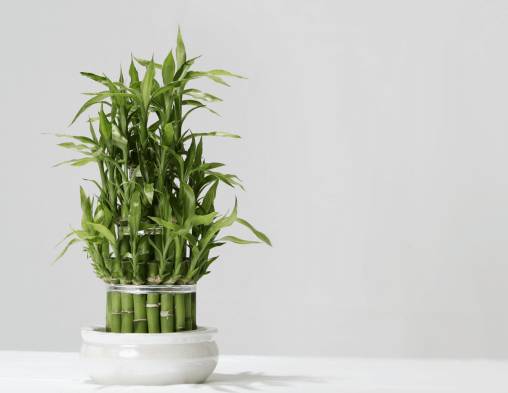
LUCKY BAMBOO WITH CARE & BENEFITS
Lucky bamboo (Dracaena sanderiana) is a captivating houseplant that graces homes and offices with its elegant presence. Despite its name, lucky bamboo isn’t a true bamboo; it belongs to the Dracaena family. Its slender, green stalks and delicate leaves make it a popular choice for both beginners and seasoned plant enthusiasts.
Bright, Filtered Sunlight: Lucky bamboo prefers bright, filtered sunlight, similar to what you’d find under a rainforest canopy. Place it near a window with indirect light exposure. Avoid direct sunlight, as it can scorch the leaves.
Low Light Tolerance: While lucky bamboo grows best with plenty of bright indirect light, it can tolerate periods of low light conditions—typically around 100 foot-candles (ftc) or less. Low light areas include obstructed north-facing windows or spaces away from windows, such as the middle of a room.
Adaptability: Lucky bamboo can survive in low light, but it won’t thrive at this level. If you notice the plant stretching or the green color fading, consider providing more light. Rotating the plant periodically ensures even light distribution.
In summary, while lucky bamboo can manage in low light, it’s ideal to place it where it receives bright, indirect sunlight for optimal growth and health. Whether you’re a seasoned plant enthusiast or a beginner, lucky bamboo’s adaptability makes it a delightful addition to any indoor space!
Cultural Significance
In Chinese traditions, lucky bamboo is more than just a decorative plant—it symbolizes various blessings and positive energies. The number of stalks in a lucky bamboo arrangement holds specific meanings:
- Two Stalks: Represent love and partnership.
- Three Stalks: Symbolize happiness (Fu), wealth (Lu), and long life (Soh).
- Five Stalks: Bring balance, peace, harmony, and power to all aspects of life.
- Six Stalks: Attract good luck and prosperity.
- Seven Stalks: Promote good health.
- Eight Stalks: Signify growth and abundance.
- Nine Stalks: Bring great luck.
- Ten Stalks: Represent perfection.
- Twenty-one Stalks: Convey a powerful blessing.
Interestingly, you won’t find traditional lucky bamboo arrangements with four stalks. In Chinese culture, the word for “four” sounds similar to the word for “death,” making it an unlucky number. Thus, gifting four bamboo stalks would be considered rude, as if wishing ill upon the recipient.
Growing and Caring for Lucky Bamboo
Light
- Lucky bamboo thrives in bright, filtered sunlight, similar to the gentle light found under a rainforest canopy.
- Avoid direct sunlight, as it can scorch the leaves.
- Rotate the plant regularly to ensure even light distribution.
Soil
- Plant lucky bamboo in well-drained, rich potting soil.
- Keep the soil consistently moist but not waterlogged.
Watering
- Use good-quality water to keep your lucky bamboo healthy.
- If the plant stretches or the green fades, provide more light.
Toxicity
- While lucky bamboo brings good fortune to humans, it’s toxic to cats and dogs. Keep it out of their reach.
Pruning and Propagation
Pruning
- Remove yellowing or damaged leaves to maintain the plant’s appearance.
- Prune sparingly to avoid stressing the bamboo.
Propagation
- Lucky bamboo can be propagated through division.
- Separate offsets (new shoots) from the parent plant and replant them.
Fun Facts
- Lucky bamboo is native to Africa, not Asia, despite its name.
- It’s a succulent plant, not a true bamboo.
- Outdoors, lucky bamboo can grow over a foot in just six months.
- Indoors, it rarely blooms.
Conclusion
Lucky bamboo brings a touch of elegance and positive energy to any space. Whether you choose a simple arrangement or an intricate design, this resilient plant will thrive with minimal care. So go ahead, embrace the symbolism, and let lucky bamboo enhance your home or office. May it bring you prosperity, happiness, and a little extra luck!
Propagating Lucky Bamboo: Two Methods
1. Water Propagation:
Select a Healthy Cutting:
- Cut an offshoot (side shoot) from the parent plant. Aim for a cutting that is around 4 to 6 inches long.
- Use clean pruners or scissors to make the cut as close to the parent stalk as possible.
- Remove leaves from the lower half of the cutting, but ensure at least one set of leaves remains at the top.
2. Place in Water:
- Fill a small glass or vase with distilled water (approximately 1-2 inches deep).
- Submerge the cut end of the lucky bamboo cutting in the water, making sure the node (from which roots will grow) is underwater.
- Avoid completely submerging the stem to prevent rot.
Root Development:
- Keep the glass or vase in a warm spot with bright, indirect light.
- Change the water every few days to maintain freshness.
- Roots will begin to form within a few weeks.
2. Soil Propagation:
Prepare the Cutting:
- Follow the same steps to select a healthy cutting as described above.
Optional Rooting Hormone:
- Apply a rooting hormone to the cut end of the lucky bamboo if desired (though it’s not essential).
Plant in Soil:
- Use a small container with drainage holes filled with a well-draining potting mix (such as cactus soil).
- Plant the cut end a couple of inches down into the soil, ensuring at least one node is below the soil line.
- Firmly pack the soil around the cutting.
Light and Water:
- Place the container in a warm spot with bright, indirect light.
- Water the soil lightly to keep it consistently moist (but not soggy).
Additional Tips:
- Take multiple cuttings at once to have backups in case some don’t form roots.
- Remember that the new lucky bamboo plant won’t have the same distinctive stalks as the parent but will still be a pretty and resilient houseplant.
Whether you choose water or soil propagation, lucky bamboo will continue to bring its positive energy and elegance to your space!
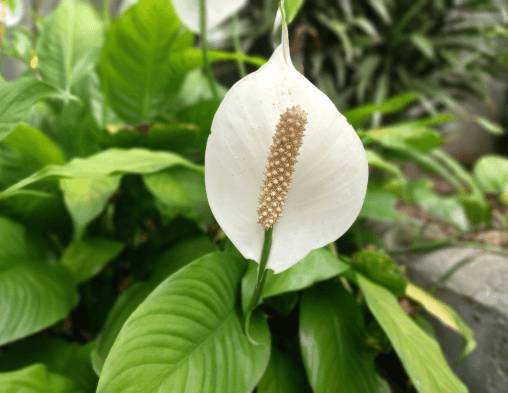
PEACE LILY WITH CARE & BENEFITS
Peace Lily: A Symbol of Elegance and Tranquility
Introduction
The peace lily (Spathiphyllum) is a beloved indoor plant known for its glossy green leaves and elegant white flowers. Despite its name, the peace lily is not a true lily; it belongs to the Araceae family, which includes other favorites like caladiums, elephant ears, anthuriums, and callas. In this comprehensive blog post, we’ll explore the world of peace lilies, from their care requirements to their symbolism.
Key Characteristics
- Botanical Name: Spathiphyllum
- Common Names: Peace lily, spath
- Family: Araceae
- Native Area: Tropical regions of the Americas and southeastern Asia
Growing Conditions
1. Light
- Peace lilies thrive in bright, indirect light. Place them near a north- or east-facing window.
- They can tolerate lower light levels, making them ideal for offices or rooms with limited sunlight.
- Peace lilies thrive in bright, indirect light. Place them near a north- or east-facing window.
- They can tolerate lower light levels, making them ideal for offices or rooms with limited sunlight.
2. Soil
- Use a well-draining potting mix with good aeration.
- Keep the soil consistently moist but not waterlogged.
3. Watering
- Water peace lilies when the top inch of soil feels dry.
- Wilting leaves indicate the need for water, but avoid overwatering.
4. Temperature and Humidity
- Peace lilies prefer warm, humid environments.
- Avoid cold drafts and sudden temperature fluctuations.
Blooming and Symbolism
1. Flowers
- Peace lilies produce showy white flowers called spathes.
- These elegant blooms symbolize purity, tranquility, and spiritual growth.
2. Low Light Flowering
- Unlike many foliage plants, peace lilies flower in low light conditions.
- Their ability to bloom even in dimly lit spaces adds to their allure.
Common Issues and Troubleshooting
1. Yellow Leaves
- Yellowing leaves may result from overwatering or insufficient light.
- Adjust watering and ensure adequate light exposure.
2. Brown Tips
- Dry indoor air or underwatering can cause brown leaf tips.
- Increase humidity or adjust your watering routine.
3. Pests
- Keep an eye out for common houseplant pests like spider mites or aphids.
- Regularly inspect your peace lily for signs of infestation.
Fun Facts
- Peace lilies are native to central America.
- They are evergreen herbaceous perennials with large leaves.
- Outdoors, peace lilies can grow up to 65 cm long.
- Indoors, they rarely bloom.
Conclusion
The peace lily’s graceful appearance and low-maintenance nature make it a perfect addition to any home or office. Whether you’re a seasoned plant enthusiast or a beginner, cultivating peace lilies will bring a sense of calm and elegance to your space. So go ahead, embrace the serenity of the peace lily, and let its white blossoms remind you of life’s simple beauty!
View More
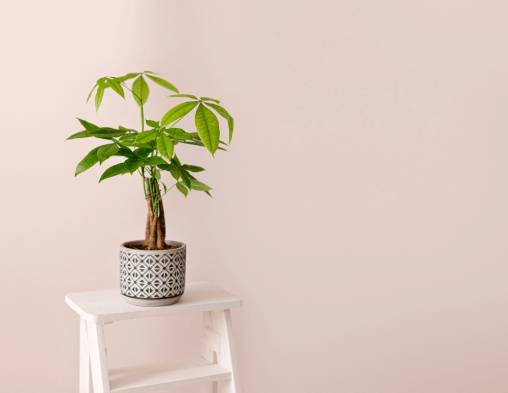
MONEY PLANT WITH CARE & BENEFITS
Money Plant: A Green Treasure for Prosperity
Introduction
The money plant (Epipremnum aureum) is more than just a decorative houseplant—it’s a symbol of fortune, abundance, and positive energy. Whether you’re a seasoned plant enthusiast or a beginner, cultivating money plants can bring both greenery and prosperity to your home.
In this comprehensive blog post, we’ll delve into the fascinating world of money plants, exploring their various types, care tips, and the wealth they represent.
Types of Money Plants
1. Golden Pothos
- Botanical Name: Epipremnum aureum
- Common Name: Pothos
- Why “Money Plant”?: Pothos is popularly known as the “Money Plant” in many Asian countries, especially South Asia. It’s believed to bring good luck and financial prosperity. The heart-shaped leaves and trailing vines make it a favorite for both homes and offices.
2. Chinese Money Plant
- Botanical Name: Pilea peperomioides
- Why “Money Plant”?: The coin-shaped green leaves of the Chinese Money Plant attract positive energy and financial abundance. It’s a favorite in feng shui practices.
3. Money Tree
- Botanical Name: Pachira aquatica
- Why “Money Plant”?: According to feng shui principles, the Money Tree brings good fortune because it produces five leaves per stem—a number associated with wealth, health, and prosperity.
4. Jade Plant
- Botanical Name: Crassula ovata
- Why “Money Plant”?: The round or oval foliage of the Jade plant symbolizes money and fortune. It’s often gifted during new ventures or business openings.
5. Rubber Plant
- Botanical Name: Ficus elastica
- Why “Money Plant”?: The leathery, green, oblong leaves of the rubber plant denote luck, wealth, and prosperity in Vastu (Indian traditional architecture). Place it at your home or office entrance.
6. Silver Dollar Vine
- Botanical Name: Xerosicyos danguyi
- Why “Money Plant”?: Also known as the “String of Coins,” this plant features oval leaves resembling coins. Some people refer to it as the money plant as well.
7. Split Leaf Money Plant
- Botanical Name: Monstera deliciosa
- Why “Money Plant”?: The Split-Leaf Money Plant, also called the Swiss Cheese Plant, is drought-tolerant and thrives in low-light conditions. Its large, split green leaves are believed to bring luck and fortune.
- Botanical Name: Monstera deliciosa
- Why “Money Plant”?: The Split-Leaf Money Plant, also called the Swiss Cheese Plant, is drought-tolerant and thrives in low-light conditions. Its large, split green leaves are believed to bring luck and fortune.
8. Monkey Mask Money Plant
- Botanical Name: Monstera adansonii
- Why “Money Plant”?: The Monkey Mask Money Plant has variegated, oval-shaped leaves with perforations. It’s often grown in the southeast corner of living rooms for cascading beauty and luck.
Caring for Your Money Plants
- Light: Provide bright, indirect light for most money plants. They can tolerate low light but thrive with more illumination.
- Soil: Use well-draining potting mix.
- Watering: Keep the soil consistently moist but not waterlogged.
- Temperature and Humidity: Warm, humid environments suit money plants.
- Pruning: Remove yellowing leaves to maintain appearance.
- Propagation: Money plants can be propagated through cuttings.
- Light: Provide bright, indirect light for most money plants. They can tolerate low light but thrive with more illumination.
- Soil: Use well-draining potting mix.
- Watering: Keep the soil consistently moist but not waterlogged.
- Temperature and Humidity: Warm, humid environments suit money plants.
- Pruning: Remove yellowing leaves to maintain appearance.
- Propagation: Money plants can be propagated through cuttings.
- Light: Provide bright, indirect light for most money plants. They can tolerate low light but thrive with more illumination.
- Soil: Use well-draining potting mix.
- Watering: Keep the soil consistently moist but not waterlogged.
- Temperature and Humidity: Warm, humid environments suit money plants.
- Pruning: Remove yellowing leaves to maintain appearance.
- Propagation: Money plants can be propagated through cuttings.
Fun Facts
- Money plants are native to various regions, including central America and southern Africa.
- They are evergreen succulents with thick stems and glossy leaves.
- Outdoors, some money plants can grow over a foot long.
- Indoors, they rarely bloom but continue to bring wealth and green beauty.
- Money plants are native to various regions, including central America and southern Africa.
- They are evergreen succulents with thick stems and glossy leaves.
- Outdoors, some money plants can grow over a foot long.
- Indoors, they rarely bloom but continue to bring wealth and green beauty.
